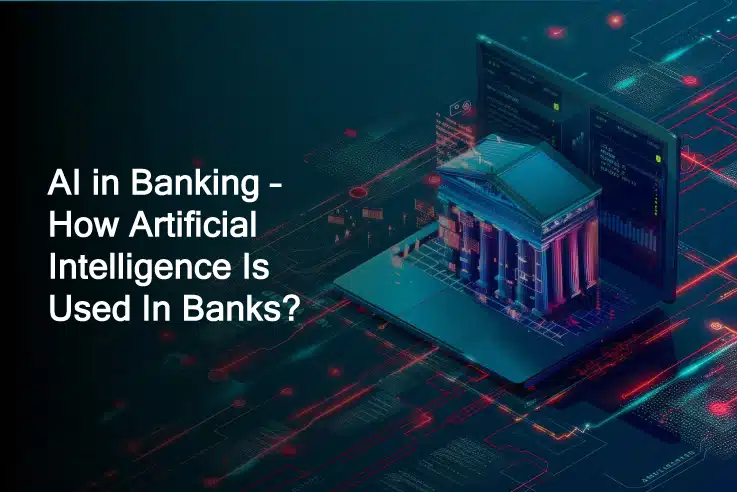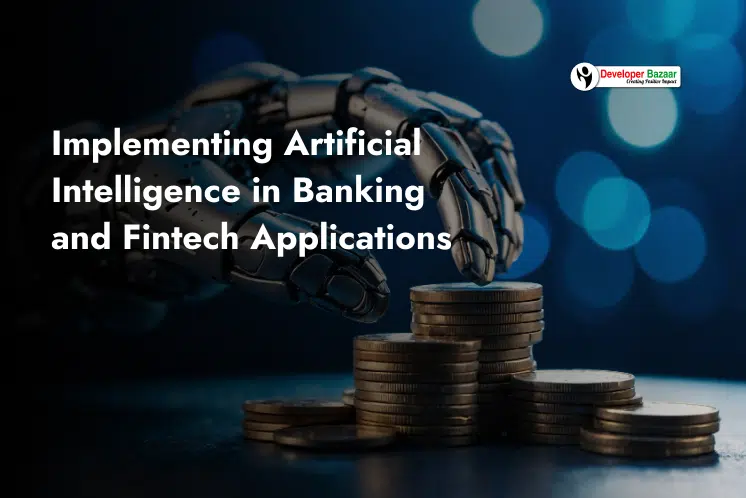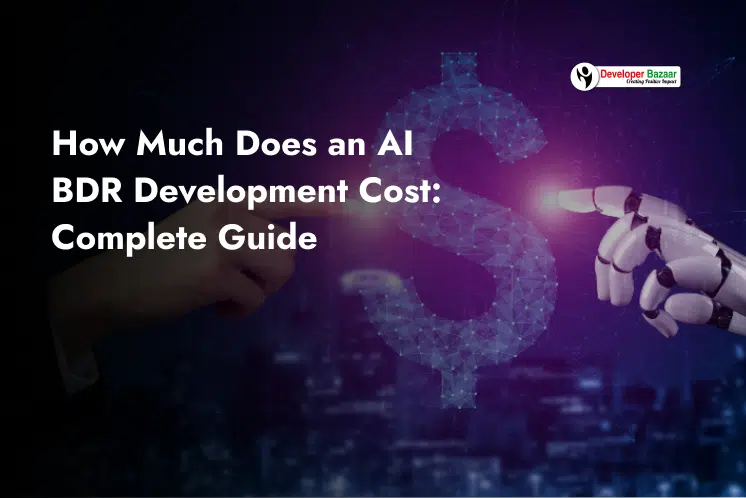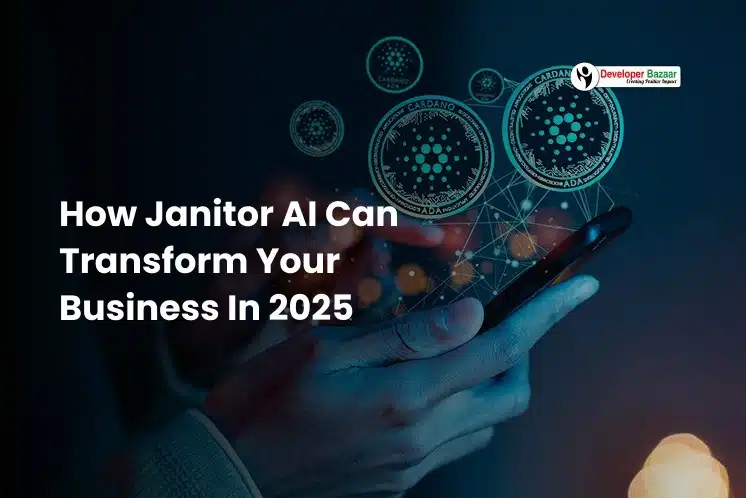Table of Contents
ToggleSince the beginning, artificial intelligence (AI) has had a major effect, particularly in the banking and finance sector. It has changed the way banks run and communicate with their customers, leading them to become more technologically advanced and customer-focused.
These days, artificial intelligence (AI) systems are saving banks money by increasing productivity and using data that would be too complicated for humans to handle to make decisions. In just a couple of seconds, these clever algorithms can also identify fraudulent activity.
Nearly 80% of banks, according to Business Insider, are aware of the advantages of AI. According to McKinsey, artificial intelligence (AI) has the potential to be worth up to $1 trillion in the banking and finance industry.
These numbers demonstrate how quickly the banking and finance sector is implementing AI to increase productivity, improve services, reduce costs, and improve efficiency.
Furthermore, AI is transforming customer service by means of chatbots and virtual assistants, offering 24/7 support and quickly solving customer concerns. AI-powered predictive analytics enables banks to provide customised financial products and advice based on the needs of each individual customer. In addition, banks are finding it simpler to identify and reduce financial risks thanks to AI-driven risk management solutions, which improves operational stability and security.
AI is changing not just how banks manage risk and provide customer service, but also how they handle compliance with regulations. Regulations change frequently, making it difficult to stay on top of them. However, AI-powered systems can swiftly adjust to new guidelines, guaranteeing banks stay compliant without requiring laborious manual updates. This saves time and resources while also lowering the chance of non-compliance.
Additionally, AI is significantly improving security. Advanced algorithms for machine learning are capable of examining trends and actions to identify unusual actions that might point to fraud or cyberattacks. By being proactive, security breaches can be avoided before they cause serious harm.
AI is also simplifying credit and loan procedures. AI can assess an applicant’s trustworthiness more quickly and accurately than traditional methods by analysing large amounts of data. Customers and banks equally gain from quicker approval times and more trustworthy lending decisions as a result.
Artificial intelligence (AI) is being used in investment banking to predict market trends and make intelligent choices when trading. Banks have an advantage over competitors in the market because algorithms can process and analyse financial data at speeds and accuracy that are not possible for humans.
In this blog, we’ll explore the main uses of artificial intelligence (AI) in the banking and finance industry, as well as how its outstanding benefits are changing the way customers interact with technology.
???? Also Read: How Much Does Pinterest Like App Development Cost?
Real-World Examples of AI in Banking
Here are some real-life examples of banks making the best use of artificial intelligence.
JPMorgan Chase: Researchers have developed an early warning system that detects malware, trojans, and phishing attempts using artificial intelligence (AI) and deep learning. They discovered that a trojan typically takes 101 days to enter corporate networks. There is plenty of notification before an attack occurs thanks to this early warning system. It notifies the cybersecurity team of the bank when hackers are preparing to infect the network by sending malicious emails to staff members.
Furthermore, this system helps in understanding the strategies of hackers in addition to identifying possible threats, allowing the cybersecurity team to prevent malicious activity before it arises. The network’s security is guaranteed by the AI’s increased ability to predict and prevent attacks through the analysis of patterns and behaviours. Because of its proactive approach, JPMorgan Chase is a leader in cybersecurity innovation, protecting sensitive financial information and reducing downtime.
Capital One: A good example of artificial intelligence in personal banking is Capital One’s Eno, an intelligent virtual assistant. Eno helps clients by keeping an eye on account activity, sending out proactive alerts, and providing real-time insights. Eno also facilitates money management through text-based communication, increasing accessibility and user-friendliness of banking.
Virtual card numbers are also used by Capital One to improve security and prevent credit card fraud. In order to ensure safer online transactions, these virtual numbers serve as a buffer between the customer’s actual card information and potential fraudsters. This creative strategy increases consumer confidence in digital financial services while also protecting users.
Capital One is exploring the limits of technological innovation in addition to these features. In this field of study, creative thinking and innovative, clear decision-making are taught to computers. Capital One believes to improve customer experience and operational efficiency by developing increasingly advanced AI systems that can come up with innovative solutions to challenging problems through the advancement of computational creativity.
Ally Financial: For more than a century, Ally has been an important player in the banking sector. It has recently made great progress in incorporating artificial intelligence (AI) into its mobile banking app. A chatbot powered by machine learning has been added to the bank’s mobile platform to help users with a variety of tasks, such as handling transfers, processing payments, and responding to inquiries. This chatbot improves user experience by providing smooth interactions and payment summaries. For example, users can easily text or speak their requests to the chatbot to efficiently manage their banking needs because it is both text and voice enabled.
Ally’s AI-driven strategy includes insights based on user behaviour and personalised financial advice in addition to these features. Through the examination of transaction patterns and financial behaviours, the chatbot can provide customised suggestions to help users in making well-informed choices. Moreover, the incorporation of artificial intelligence guarantees strong security protocols by employing sophisticated algorithms to identify and prevent fraudulent actions. By combining modern technology with traditional banking knowledge, Ally establishes itself as a progressive organisation dedicated to satisfying modern client needs. Ally’s early adoption of these advancements in AI highlights its commitment to improving customer service and operational effectiveness in the digital age as the technology develops.
???? Also Read: How Much Does It Cost to Create an App in Australia?
Applications of AI in Banking and Finance
Our world has become more and more dependent on artificial intelligence, and banks are currently integrating this technology into their offerings. The following are some significant uses of AI in the banking sector:
Cybersecurity and Fraud Detection
Artificial intelligence (AI) has made significant progress in two important areas for the banking and finance industry: cybersecurity and fraud detection. Financial institutions use AI technologies, especially machine learning and deep learning algorithms, to improve their security protocols. With the use of these technologies, huge amounts of data can be analysed in real time to find trends and defects that might point to fraud. In order to identify suspicious behaviours that don’t match a customer’s typical patterns, such as atypical spending or unexpected login locations, AI systems, for example, can monitor transactions across a variety of channels, including online banking, mobile apps, and ATMs.
By using past data to train their models, machine learning algorithms are able to continuously learn and adjust to new fraud strategies, increasing their predictive accuracy over time. To identify possible fraud indicators, unstructured data—such as customer communications and transaction descriptions—is analysed using techniques like neural networks and natural language processing. Furthermore, fraud investigation and resolution can be automated by AI-powered systems, which greatly reduces response times and operating expenses compared to manual fraud detection procedures. In the end, this proactive approach protects the integrity of the banking and finance industry by improving customer trust, improving the security of financial transactions, and increasing compliance with regulatory requirements.
Danske Bank, Denmark’s biggest bank, started using a smart computer program to catch fraud. This special program uses advanced technology to spot fraud better than before. It helped the bank find 50% more fraud cases and made fewer mistakes by 60%. The program also made it easier for the bank to handle decisions automatically, though some cases still needed human experts to look into them carefully.
Chatbots:
Artificial intelligence-based chatbots have transformed customer service and operational efficiency in the banking and finance industry. These AI-powered conversational agents provide 24/7 support and are skilled at managing a variety of consumer enquiries and transactions in real-time. Bots that use machine learning algorithms and natural language processing (NLP) are able to understand and reply to consumer inquiries about account balances, transaction histories, loan applications, and even complicated financial products.
One of the best examples of AI chatbots for banking apps is Erica, a virtual assistant from the Bank of America.
Additionally, by making customised suggestions based on user interactions and past data analysis, chatbots improve customer engagement. By quickly addressing common problems, they speed up the customer support process, cutting down on wait times and increasing customer satisfaction levels. Financial institutions can save a lot of money by using chatbots to automate repetitive tasks and free up human agents to handle more complex inquiries. Additionally, by guaranteeing accurate and consistent distribution of data, chatbots powered by AI help improve regulatory compliance.
In the future, chatbot capabilities in banking and finance will continue to grow with the integration of modern AI technologies. In the future, chatbots could become even more essential tools in the financial services sector with the introduction of proactive advisory services and improved predictive analytics for predicting customer needs.
Loan and Credit Decisions:
By using huge amounts of data and advanced algorithms to increase accuracy and efficiency, artificial intelligence (AI) has completely changed loan and credit decisions in banking and finance. In order to assess creditworthiness, machine learning models examine past data, seeing trends that more conventional approaches might miss. To effectively predict the chance of default, these models consider factors like transactional behaviour, income, employment status, and credit history.
AI also makes it possible for institutions to monitor borrower activities in real-time, which helps them identify possible risks early on. This proactive strategy helps in reducing fraud and efficiently managing non-performing loans. Furthermore, unstructured data from sources like social media and customer inquiries can be analysed by natural language processing (NLP) algorithms, offering further insights into the thoughts and financial actions of customers.
Additionally, automation is essential since it speeds up and reduces the loan application process. Artificial intelligence (AI)-enabled chatbots can respond to consumer inquiries, offer tailored guidance, and help with application completion, all of which improve customer satisfaction and business productivity.
All things considered, artificial intelligence (AI) in banking and finance changes loan and credit decisions through improving risk management, enhancing customer satisfaction, and simplifying operational procedures. These factors promote improved financial inclusion and long-term industry growth.
Tracking Market Trends:
The banking and finance industry has experienced a technological shift thanks to artificial intelligence (AI), especially in the area of market trend tracking. Financial institutions can now analyse huge quantities of data in real-time and extract insightful information that helps them make informed investment and risk management decisions thanks to artificial intelligence (AI) and its advanced algorithms and machine learning techniques.
Predictive analytics is one important area where AI is being used. AI models have the remarkable ability to forecast market trends with remarkable accuracy by analysing historical data and current market information. Financial analysts and traders can now predict market movements, spot new opportunities, and reduce risks before they become more serious due to this capability.
Furthermore, organisations can keep an eye on news, social media, and other unstructured data sources thanks to AI-driven technologies like sentiment analysis and natural language processing (NLP). With the help of these tools, one can better understand investor behaviour and market dynamics by extracting sentiment and measuring shifts in market sentiment.
In addition, AI-powered algorithms are always learning from fresh data inputs, improving their models and instantly adjusting to shifting market conditions. This flexibility is essential in the quick-changing financial markets of today, where even minute changes can have an important impact.
In summary, AI’s capacity to monitor market trends improves decision-making procedures and promotes innovation in the financial sector, leading to increased efficiency, transparency, and ultimately better results for investors and institutions equally.
Data Collection and Analysis:
AI’s advanced data collection and analysis capabilities are a key factor in the transformation of banking and finance. Financial institutions can effectively collect huge amounts of customer data from various sources by using machine learning algorithms and big data analytics. This makes it possible to provide risk assessment, fraud detection, and personalised services with never-before-seen accuracy and speed. In order to automate trading strategies, optimise investment portfolios, and forecast market trends, artificial intelligence (AI) algorithms can examine past data. AI-driven insights also make it easier to make decisions in real time, which improves customer satisfaction and operational effectiveness. In the end, these technologies enable financial institutions like banks to successfully navigate complicated rules and regulations and provide customised financial solutions to satisfy changing client demands.
Customer Experience:
Through a variety of applications, artificial intelligence (AI) is transforming the banking and finance industry’s customer experiences. Customised services is an interesting field where artificial intelligence analyses the customer data to customise suggestions and resolutions. Artificial intelligence (AI)-powered chatbots respond to consumer inquiries instantly, improving accessibility and cutting down on wait times. By examining patterns and irregularities in transactions in real-time, AI algorithms additionally improve security and trust by improving fraud detection. Furthermore, based on each person’s unique financial habits and objectives, AI-driven predictive analytics helps in providing proactive financial advice, such as investment strategies and savings plans. In addition to increasing customer satisfaction, this proactive strategy strengthens customer loyalty. In overall, artificial intelligence in banking and finance improves customer experiences by customised, simplifying, protecting, and predicting interactions. This eventually results in a more fulfilling and reliable relationship between financial institutions and their clients.
Risk Management:
Through improving decision-making processes’ accuracy and efficiency, artificial intelligence (AI) is a key factor in the transformation of risk management in the banking and finance industry. Large volumes of historical data are analysed by machine learning algorithms, which help them identify patterns and trends that human analysts might overlook. Financial institutions may assess risks more deeply and believe possible threats more accurately due to this capability.
In order to deliver risk assessments on time, AI models can also continuously monitor real-time data from a variety of sources, including market fluctuations, consumer behaviour, and regulatory changes. By enabling proactive risk mitigation techniques, these insights help banks and other financial institutions in improving overall portfolio management and capital allocation.
AI-powered risk management systems can also quickly identify irregularities and fraudulent activity, which lowers losses and improves security. Organisations can achieve a stronger and more flexible approach to risk assessment by integrating AI into their risk management frameworks. This will guarantee compliance with regulations while increasing profitability and maintaining customer trust in an increasingly complex financial landscape.
Regulatory Compliance:
AI is essential to the banking and finance industry as it uses cutting-edge technologies to guarantee regulatory compliance. Real-time transaction monitoring is done by AI algorithms, which also highlight suspicious activity and improve fraud detection capabilities over and above traditional methods. By helping in the analysis of huge quantities of regulatory texts and updates, natural language processing (NLP) makes sure that institutions remain up to date with changing compliance requirements. Predictive analytics powered by AI can also assess risk profiles more accurately, which helps with proactive compliance measures. These developments help financial institutions meet strict standards and quickly adjust to regulatory changes in a complex and dynamic global environment by streamlining operations and reducing regulatory risks.
Predictive Analytics:
Banking and finance are being transformed by AI-powered predictive analytics, which uses large datasets to predict future trends and behaviours. In order to improve security and lower losses, artificial intelligence (AI) algorithms in banking examine consumer spending patterns to calculate credit risk and identify fraud in real-time. Predictive models in finance use past data and market signals to forecast market trends, optimise investment portfolios, and enhance trading strategies. Through risk assessments and tailored recommendations, these apps not only speed up decision-making procedures but also improve customer experiences. In the end, AI-powered predictive analytics drives profitability, creativity, and efficiency throughout the banking and finance sectors, resulting in a more adaptable and competitive market environment.
Process Automation:
Artificial Intelligence is transforming traditional operations in banking and finance through process automation. Algorithms based on artificial intelligence (AI) improve accuracy and efficiency by simplifying operations like data entry, transaction processing, and customer support enquiries. Automation lowers the possibility of human error, speeds up the decision-making process, and guarantees commitment to legal requirements. AI chatbots, for example, respond to standard customer inquiries 24/7, and machine learning models scan large datasets to identify fraud trends instantly. This technology examines credit risks quickly and completely which also improves loan approvals. All things considered, AI-driven automation lowers expenses while allowing financial institutions to provide quicker, more dependable services, which eventually raises client satisfaction and boosts operational efficiency.
???? Also Read: How Much Does It Cost to Create an App in Canada?
Challenges in Adopting AI & ML in Banking
There are a number of challenges when implementing modern technologies like AI in banks. In addition to security issues, banks frequently struggle to obtain trustworthy and high-quality data. They deal with the following main problems:
Data Security:
Massive amounts of data are collected by banks, and it is necessary to protect this data to stop violations and misuse. It’s important to find a technology partner who is knowledgeable about AI and the banking sector. To appropriately protect client data, this partner should provide strong safety precautions.
Your tech partner should offer advanced technologies like fraud detection systems and real-time monitoring to promptly identify and address potential threats in addition to strong security. To make sure your bank meets all legal requirements, they should also be knowledgeable about the most recent compliance regulations.
Furthermore, with the correct partner, operations can be streamlined with AI-powered tools that improve decision-making, customer service, and overall efficiency. Customers may have a more positive banking experience as a result, and your bank may have a safer, more effective system. Selecting a technology partner that is capable of providing these complete solutions can help your bank in maintaining its lead in the constantly shifting financial market.
Lack of Quality Data:
Before banks may use AI systems more generally, they must first properly train and test them using well-organized, high-quality data. Solid data contributes to the AI’s ability to function well in practical scenarios. In the event that the data is not in a computer-readable format, the AI may act in a random way. As a result, banks implementing AI must update their data policies to cover all risks related to privacy and compliance.
To enhance AI performance, banks should also concentrate on defining and cleaning their data. This involves removing the data of any mistakes, duplications, or inconsistencies. Effective data management can also support trend detection and improved decision-making. To prevent breaches of sensitive data, banks must also invest in secure data storage solutions. They may guarantee the safe and efficient use of AI technologies by doing this and gaining the trust of regulators and customers. Updating data policies and conducting regular audits are both essential for maintaining compliance with changing regulations.
Lack of Explainability:
AI systems are excellent for making decisions because they save time and minimize errors. They are able to learn affects from previous human mistakes, though. The operations and reputation of the bank could be harmed by even minor AI errors that swiftly grow into major issues.
Banks should make sure that all AI-generated decisions and recommendations are simple to understand and clarify in order to avoid such problems. Banks must be able to clearly explain the AI’s decision-making process, verify its accuracy, and know how it works.
In order to make sure that their employees are knowledgeable about the most recent advancements in AI, banks should also regularly invest in training them. They will be better able to manage AI systems and identify possible issues early on. In order to reduce opinions and increase fairness, banks can also use a variety of data sets for AI training. By taking these steps, banks can take advantage of AI’s advantages while reducing its risks, guaranteeing a more secure and valid system.
???? Also Read: How Much Does It Cost to Create an App in Vietnam?
Why Must the Banking Sector Embrace the AI-First World?
In order for the banking industry to stay efficient, competitive, and customer-focused in the increasingly digital economy, it must adopt an AI-first mindset. AI presents banks with previously unknown chances to improve decision-making, cut expenses, and streamline operations. AI allows bank workers to concentrate on more complex and valuable tasks by automating repetitive ones, which boosts output and creativity.
AI also enhances the client experience by offering customized support and quicker responses. Banks can provide 24/7 support by using AI-powered chatbots and virtual assistants to quickly address customer questions and concerns. AI also improves risk management and fraud detection by detecting suspicious activity, analyzing large volumes of data in real time, and lowering the possibility of financial crimes.
Furthermore, banks can customize products and services to match individual needs due to deeper insights into customer behavior and preferences provided by AI-driven analytics. Increased customer loyalty and stronger relationships are created by this level of personalization. Because AI systems can help ensure that businesses meet changing standards and requirements, adopting AI also puts banks in a better position to adapt to regulatory changes more quickly.
In conclusion, in order to take advantage of AI’s transformative potential, promote operational excellence, raise customer satisfaction, and maintain an advantage in the quickly changing financial landscape, the banking industry must adopt an AI-first strategy.
The Generative AI Impact
Banks are using AI to help them meet the demands of their customers because they face many difficulties in doing so. With its powerful tool, generative AI, banks can solve a lot of their current problems by combining and analyzing massive amounts of data. This reduces errors and risk factors by simplifying decision-making and improving forecasts.
Additionally, banks can generate realistic fake data for model training without compromising privacy thanks to generative AI. It helps banks stay compliant and provide better customer service by automatically writing financial reports, regulatory documents, and customer messages quickly.
Furthermore, by learning from transaction patterns, generative AI can create advanced algorithms to identify fraud, significantly improving security. Banks can handle risks more securely, communicate with customers more successfully, and manage challenges better by utilizing generative AI.
Furthermore, generative AI can help customers make better decisions by modifying financial advice to their specific financial situation. In addition, it can help banks in providing better investment options by forecasting market trends. Accepting these AI applications can result in a banking environment that is more customer-friendly, safe, and effective.
???? Also Read: How Much Does It Cost to Create an App in Manila, Philippines?
Steps to Become an AI-First Bank
In order to satisfy consumer needs and maintain its level of competition in an increasingly digital world, the banking sector must keep up with technological developments. Prioritizing artificial intelligence in your operations, decision-making, and customer interactions is what it means to become an AI-first bank. The following are the most important steps to become an AI-first bank:
1. Develop a Clear AI Strategy
A clearly defined strategy is the first step on the path to becoming an AI-first bank. Start by determining the primary domains, such as customer service, risk management, fraud detection, and operational efficiency, where artificial intelligence may provide the greatest benefits. Create exact, measurable objectives and deadlines for the use of AI. Make sure that your plan has the backing of upper management and is in line with the general business goals.
2. Invest in the Right Technology
Banks must make the necessary technological infrastructure investments if they want to fully utilize AI. This covers cloud computing resources, machine learning models, and advanced analytics platforms. Banks will be able to quickly and accurately process and analyze huge amounts of data thanks to these tools. Additionally, to guarantee smooth operations and data flow, think about integrating AI solutions with current systems.
3. Build a Skilled Workforce
A workforce with the necessary knowledge and experience is necessary for an AI-first bank. Invest in educational programs to upskill present staff members and attract in new employees with expertise in data science and artificial intelligence. Establish a culture of lifelong learning where staff members are motivated to keep up with the newest developments in artificial intelligence. For AI solutions to be developed and implemented successfully, cooperation between banking professionals and AI experts is essential.
4. Ensure Data Quality and Accessibility
Because AI systems rely so heavily on data, it is important to make sure your data is accessible and of high quality. Establish strong data governance guidelines to preserve the security, consistency, and accuracy of your data. To get data ready for analysis, use preprocessing and data cleaning techniques. Create a central database as well as provide quick access to relevant information for AI applications.
5. Focus on Ethical AI Practices
When deploying AI, ethical issues are important. Provide a framework for moral AI that outlines rules for accountability, justice, and transparency. Make sure AI models are neutral and don’t target any particular customer base improperly. Conduct routine audits of AI systems to find and address any potential ethical problems. Prioritizing ethical AI procedures will help banks gain the trust of both the government and consumers.
6. Enhance Customer Experience
Improving the client experience is a key objective of becoming a bank that promotes artificial intelligence. Use virtual assistants and chatbots powered by AI to offer 24/7 customer service. Offer customized financial guidance and product recommendations by utilizing predictive analytics. AI may also speed up and improve the onboarding process, giving new clients a faster, more effective experience. Banks can offer a more individualized and responsive customer experience with the help of AI.
7. Strengthen Fraud Detection and Risk Management
AI has the potential to greatly improve risk management and fraud detection. Create AI models that examine transaction patterns in order to immediately identify questionable activity. Make use of machine learning algorithms to predict and minimize risks before they become serious problems. Banks can guard against financial fraud and losses for both themselves and consumers by implementing AI into these important domains.
8. Foster Innovation and Experimentation
Promote an innovative and experimental culture within your company. Establish AI innovation labs where groups can work together to design, develop, and test new AI uses. Ask staff members to investigate new applications and try out AI technology. Banks can stay ahead of the competition and continuously improve their AI capabilities by growing a culture of innovation.
9. Collaborate with AI Partners and Startups
The transition to an AI-first bank can be increased by working with startups and AI partners. Join forces with AI technology providers to get access to the newest resources and knowledge. Talk to startups that are creating modern AI products specifically for the banking sector. These partnerships may accelerate the adoption of AI within your company and offer insightful information.
10. Monitor and Evaluate AI Performance
Lastly, keep an eye on and figure out AI system performance constantly. Use key performance indicators (KPIs) to measure how well AI applications accomplish organizational objectives. Make sure AI models are accurate and up to date by reviewing and updating them on a regular basis. Banks can make data-driven decisions and continuously improve their AI initiatives by tracking the effectiveness of their AI initiatives.
The journey to become an AI-first bank is a transformative one that calls for a strategic plan, talent and technology investments, and a dedication to moral behavior. These actions will help banks use AI to better serve their customers, increase operational effectiveness, and keep their level of competition in the age of technology.
???? Also Read: How Much Does It Cost to Develop an App in India?
How Developer Bazaar Technologies Can Help in Your AI for Banking Journey
AI is a great fit for banking because it has a lot of advantages. 60% of financial services companies have already begun utilizing AI to improve the efficiency of their operations, according to McKinsey’s global AI survey. This indicates that artificial intelligence (AI) has a promising future in banking, as it can streamline processes, cut down on errors, and improve customer support. As a result, banks should make AI investments in order to offer their clients innovative and top-notch services.
Leading provider of AI services, Developer Bazaar Technologies, works with banks to create personalized AI and machine learning models. These models help banks in lowering expenses, raising revenue, and decreasing risk in various departments. You can use AI to make big changes with the assistance of our IT consulting experts. They can help you in developing AI solutions that improve risk management, automate processes, and improve customer experiences since they are knowledgeable about AI and the unique difficulties that banks face.
The professionals at Developer Bazaar Technologies can also help you create a long-term AI plan that is customized to your bank’s particular requirements. This include selecting the best AI tools and technologies, educating employees on how to use AI successfully, and upgrading your AI systems frequently to stay up to date with new developments in technology. You can make sure that your bank stays competitive and provides its clients with excellent services by working with Developer Bazaar Technologies.
To create and implement an effective AI strategy for your bank in the most user-friendly manner, get in touch with our experts right now.
FAQs
Q. How does AI help in Banking?
AI improves customer experiences, reduces errors, and automates processes to help the banking industry. It allows customized support, improves risk management, and streamlines operations. Artificial intelligence (AI) is capable of fraud detection, exact credit scoring, and predictive analytics for improved decision-making. In addition, by offering immediate help, chatbots powered by AI improve customer service. In general, AI improves banking’s security, customer experience, and effectiveness.
Q. How AI helps in banking risk management?
By quickly and efficiently analyzing huge amounts of data to pinpoint potential risks, artificial intelligence (AI) helps in banking risk management. It can identify unusual transaction patterns, judge credit risks more accurately, and predicted changes in the market. Algorithms powered by AI are also capable of continuously monitoring financial activity in real-time and issuing early alerts for possible fraud or compliance problems. By taking a proactive approach, banks can more successfully reduce risks and make decisions based on trustworthy data from AI systems.
Q. Which are the most important Generative AI use cases in banking?
Personalized customer interactions through chatbots and virtual assistants, automated report generation for financial analysis, fraud detection through advanced pattern recognition, and customized product recommendations based on customer data are among the most significant use cases of Generative AI in banking. These apps improve decision-making accuracy, speed up processes, improve customer service, and strengthen safety measures in banking operations.
Q. What are the top AI trends in banking?
A number of important changes have accelerated the change that artificial intelligence (AI) is bringing about in the banking industry. The growing use of virtual assistants and chatbots is one known trend. By responding to inquiries, managing them 24/7, and carrying out regular duties, these AI-powered solutions improve customer service and boost operational effectiveness.
The use of AI for fraud detection and prevention is another important trend. In order to detect and flag suspicious activity, advanced algorithms using machine learning analyse huge amounts of transaction data in real-time, lowering the risk of fraud and boosting security.
AI is enabling banks to provide customised financial advice and product recommendations based on individual customer data and behaviour patterns, which is driving the rise of personalised banking. Customer satisfaction and loyalty are increased as a result of this customisation.
AI is being used more and more in risk analysis and credit scoring. AI algorithms that take into account more types of data points are being added to traditional credit scoring methods to improve risk management and assessment accuracy.
Finally, back-office operations are being transformed by process automation. Banks can now concentrate more on their strategic goals and customer engagement by using Robotic Process Automation (RPA) and Artificial Intelligence (AI) to automate administrative tasks, reduce errors, and lower operational costs.
In addition to improving security and efficiency, these AI trends are opening the door for more creative and client-focused banking services.
Q. How AI is helping banks support sustainability transformation
By increasing productivity, lowering carbon footprints, and advancing green finance, artificial intelligence (AI) is greatly contributing to banks’ support of the sustainability transformation. First, banks can monitor and control their energy use, maximise use of resources, and reduce waste by using artificial intelligence (AI) analytics, which reduces their environmental effect. AI, for example, may predict energy requirements and automate bank building HVAC systems, saving an important amount of energy.
AI also helps with sustainable investment by identifying businesses with strong environmental, social, and governance (ESG) practices by analysing large datasets. This allows the creation of green investment portfolios by banks, which distribute funds to more environmentally friendly companies and efforts. By analysing the long-term sustainability risks connected to investments, AI may improve risk assessment and make sure banks fund projects that have a minor negative environmental impact.
AI also improves accountability and transparency in sustainable finance. With the help of advanced machine learning algorithms, banks are able to report on their sustainability metrics by tracking the carbon footprint of their financial operations. This transparency meets with legal requirements and promotes trust towards stakeholders.
Lastly, banks may communicate with customers about sustainability issues by using AI-powered tools. Customers are encouraged to adopt more sustainable behaviours, like lowering their carbon footprint or selecting eco-friendly investment options, by means of personalised insights and recommendations. AI makes an important contribution to the banking industry’s shift towards sustainability through these different uses.
Q. What are the advantages of AI in banking?
AI in banking has a number of benefits that increase customer comfort and productivity. An important advantage is customised customer support. AI is able to provide customised recommendations or alerts by analysing a customer’s spending behaviours and preferences. For example, AI can suggest a particular credit card with cashback rewards for online purchases to someone who shops a lot.
Fraud detection is an additional advantage. Artificial intelligence (AI) algorithms can identify unusual transactions or patterns that might point to fraud quickly, allowing banks to take action immediately to protect the accounts of their clients. For example, AI can identify and immediately aware a customer if their card is used for an unusually large purchase made in a foreign country.























